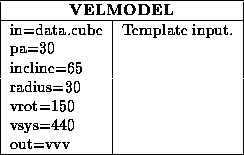
Here we illustrate typical use of the MIRIAD
tasks
velmodel
and velimage
. To make the tilted ring model one must
utilize
also imgen
and maths
(see Sections 17.7 and
17.5). The warp is simulated by varying
the inclination and position angles of successive annuli (usually suggested
from various plots from data.cube such as closure of isovelocity contours
along the major axis and twists in channel maps showing the minor axis).
The velocity rotation profile in the plane of the disk may be suggested
by inspection of position-velocity maps made with velplot. For the purpose of
this exercise we will assume a flat rotation velocity profile in the plane
of the disk of 150 km/s
. So we make the 3-dimensional data cube for each tilted
ring with velimage
and add them together with maths
.

Obviously, prior to running velimage
, we must have generated
the input files aaa and vvv which contain our assumptions about
the variation in intensity and velocity in our model.
aaa is the (x,y)
intensity distribution of what will be
model.cube
integrated over the z
-axis. In this example it is an elliptical annulus of
uniform intensity made by subtracting an inner disk from an outer disk using
maths
, the disks having been made using imgen
as follows :




vvv is a model for the velocities ( z
-axis) made using velmodel
.

Note that the input (data.cube in the above) a template only but if
you use your actual data cube you will finally end up with a model
with much of the header information the same as the data, e.g. it will
appear to be in the same position in the sky.
One makes a number of such model.cubes and adds them together
with maths
to obtain the final 3-dimensinal tilted ring model.